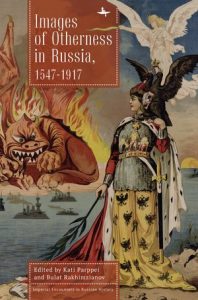A volume edited by Bulat Rakhimzianov and me, Images of Otherness in Russia, 1547-1917 has been published by Academic Studies Press.
The to pical book covers a time span of four hundred years and provides background for the formation of contemporary ideas of collective Russianness and its manifestations. Further, the volume brings into focus the processes of assimilation and integration, applied by Russian administration to the peoples residing in the areas the empire expanded to, such as Siberia and the Caucasus. While the current regime of Russia blames “the West” for colonial practices, it categorically refuses to critically assess the Russian empire’s goals and activities, often equally toned by colonial exploitation.
pical book covers a time span of four hundred years and provides background for the formation of contemporary ideas of collective Russianness and its manifestations. Further, the volume brings into focus the processes of assimilation and integration, applied by Russian administration to the peoples residing in the areas the empire expanded to, such as Siberia and the Caucasus. While the current regime of Russia blames “the West” for colonial practices, it categorically refuses to critically assess the Russian empire’s goals and activities, often equally toned by colonial exploitation.
As social and political tensions arose at the turn of the twentieth century, the empire aimed to consolidate inner cohesion by creating enemy images and stereotypes of hostile “Others.” Simultaneously, harsh propaganda was actively produced on and by competing political groups and actors. As the case studies presented in the book indicate, the borders between “Us” and the “Others” are and have always been porous and fluctuating.
The volume consists of fifteen chapters authored by researchers from the United States, Germany, Finland and Russia. The first section examines how ethnic and religious “Others” were represented and depicted in the fifteenth-seventeenth century Muscovite sources. The second section focuses on the representations of minorities, such as Tatars, Oirats and Jews, in the expanding empire from the seventeenth century to the beginning of the twentieth century. The theme of the third section are the images of “Otherness” in the empire facing multiplying and intertwining crises at the turn of the twentieth century. All the sections are preceded by summaries authored by world-renowned experts of each theme.
You will find more information here: Images of Otherness in Russia, 1547-1917 — Academic Studies Press,
